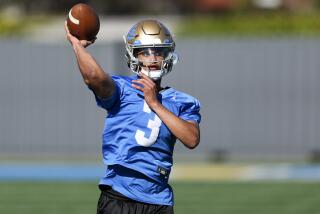Bruins goalie Tim Thomas’ feistiness is one of his biggest assets
- Share via
From Vancouver, Canada
Boston Bruins goaltender Tim Thomas was never anyone’s prize prospect.
The native of Flint, Mich., was drafted 217th by the Quebec Nordiques in 1994 and bounced around for years, playing college hockey at the University of Vermont before beginning an odyssey that wound through the best and worst minor leagues in North America, to Europe and back.
He was past his 28th birthday when he made his NHL debut and did not become a regular with the Bruins until he was over 30. But his fearless, straight-ahead approach never wavered.
“Anybody that knows the story of Tim Thomas, he’s taken a real bumpy road to get to the NHL,” Coach Claude Julien said. “He’s had so many obstacles in front of him that he’s overcome, it makes him a battler, it makes him the perfect goaltender for our organization because that’s what we are. We’re a blue-collar team that goes out and works hard and earns every inch of the ice that you can get.”
But as Julien pointed out Thursday, a day after the Bruins’ second straight thumping of the Vancouver Canucks tied the Stanley Cup finals at two games each, “Just because you’re blue-collar doesn’t mean you don’t have skill.”
Thomas’ skill might be exceeded only by his feistiness. He is aggressive in coming out of his crease and does not care if the Canucks moan and insinuate that he is a bulldozer on skates, as they have nearly every day.
Thomas threw a check on Henrik Sedin in Game 3 that any defenseman would be proud to claim, and when Alex Burrows tried to knock the stick out of his hand in Game 4, Thomas chopped Burrows in the ankle and touched off a skirmish.
Shades of a combative and successful goalie named Ron Hextall, who was renowned for punishing opponents who crowded him and wasn’t above mixing it up.
“He has played extremely well and is as competitive a goalie as there is,” said Hextall, now assistant general manager of the Kings. “He was obviously frustrated by the contact and picked his time and reacted.”
Thomas isn’t about to back off now, with the finals reduced to a best-of-three series starting Friday at Rogers Arena. Nor will his Bruins teammates ease up on the physicality that has worn the Canucks down and blunted nearly all of Vancouver’s once-potent scoring threats.
“I think it’s important for us to play the same type of game that we played the last two games. That’s what led us to the success that we had in those two games,” Thomas said Thursday.
“The challenge is doing it. It’s easy to say, ‘This is what we have to do,’ but it takes an extreme amount of effort and people laying their bodies on the line and that’s what we’re going to need as a group and as a team.”
The Bruins will need Thomas to be as focused and feisty as he has been the first four games, a triumph by the slow and steady over the flashy Roberto Luongo.
Thomas has stopped 141 of 146 shots in the Cup finals — a dazzling .966 save percentage — and his 701 saves through 22 playoff games is the second-highest total by any goalie in postseason play, behind only the 761 made by Vancouver’s Kirk McLean in 1994.
He has come up with big, game-changing saves when his team needed them. Again, that’s unlike Luongo, who has given up 14 goals on 124 shots, an .887 save percentage.
Thomas has another useful talent: the ability to visualize succeeding in various situations. So the goalie nobody could see making it in the NHL can now — with good reason — see himself winning hockey’s ultimate prize.
“I think it’s important to visualize winning the Cup; that’s what helps you to get there,” he said. “So I think it’s important to keep the same sort of visualization but not to take it any further, because things can change quick.”
twitter.com/helenenothelen
More to Read
Go beyond the scoreboard
Get the latest on L.A.'s teams in the daily Sports Report newsletter.
You may occasionally receive promotional content from the Los Angeles Times.











